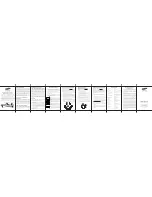
2
120 volts may cause serious injury from electrical
shock. Disconnect electrical power to the furnace & air
conditioner before starting installation. This thermostat
is not a 120 volt (line voltage) device.
Improper installation may cause serious injury from electrical
shock. This product must be installed by a qualifi ed
heating & air conditioning contractor in accordance with
NEC Standards and applicable local and state codes.
Do not use on circuits exceeding specifi ed voltage.
Higher voltage will damage control and could cause
shock or fi re hazard.
Do not short out terminals on gas valve or primary control
to test. Short or incorrect wiring will damage thermostat
and could cause personal injury and/or property damage.
Thermostat installation and all components of the system
shall conform to Class II circuits per NEC code.
MOUNTING AND WIRING
ELECTRIC/GAS JUMPER (FAN OPTION)
WARNING
If your emergency or auxiliary system will energize the blower, then
jumper W906 on the thermostat base must be cut (see
Figure 1
).
If your emergency or auxiliary heat system requires that the
thermostat energize the fan circuit, do not cut jumper W906.
If you are unsure of your application, contact a qualifi ed service person.
°F OR °C SELECTION
The factory default setting for temperature display is Fahrenheit.
If you want the temperature in Celsius, clip jumper W904.
FAST OR SLOW CYCLE SELECTION
The factory default setting is fast cycle, which cycles 1st stage with a
temperature swing of approximately 1.2°F and 2nd stage with 0.75°F.
If you prefer slow cycle, clip jumper W905. The 1st stage and 2nd
stage temperature swing will become 1.5°F and 1.2°F respectively.
PROGRESSIVE RECOVERY
This thermostat is set to operate with Progressive Recovery. This
causes the thermostat to start the heating or cooling system early to
have the room temperature reach the program setpoint at the time
the period is to start.
To disable Progressive Recovery, clip jumper W903 (see
Figure 1
).
O/B TERMINAL SELECTION SWITCH
The O/B switch on this thermostat is factory set to the “B” position.
This will accommodate the majority of heat pump applications which
require the changeover relay to be energized in HEAT. If the heat
pump being installed with this thermostat requires an “O” terminal
to energize the changeover relay in COOL, the O/B switch must be
moved to the “O” position.
Take care when securing and routing wires so they do
not short to adjacent terminals or rear of thermostat.
Personal injury and/or property damage may occur.
CAUTION
BATTERY LOCATION
This thermostat does not require batteries to operate. The 2 “AAA”
alkaline batteries are for the thermostat to remember the programming
if AC voltage is lost. If the display shows BATT when AC power is
not present, the batteries are low and should be replaced with fresh
“AAA” Energizer
®
alkaline batteries. To replace the batteries, install
the batteries along the top of the base (see
Figure 1
). The batteries
must be installed with the positive (+) ends to the right.
THERMOSTAT APPLICATIONS
Description
Heat Pump (No Aux or Emergency Heat)
Yes
Heat Pump (with Aux or Emergency Heat)
Yes
Standard Heat & Cooling Systems
No
Standard Heat Only Systems
No
Millivolt Heat Only Systems – Floor or Wall Furnaces
No
Description
Standard Central Air Conditioning
No
Gas or Oil Heat
No
Electric Furnace
No
Hydronic (Hot Water) Zone Heat – 2 Wires
No
Hydronic (Hot Water) Zone Heat – 3 Wires
No
CHOOSE A LOCATION TO MOUNT THE THERMOSTAT
MOUNT THE THERMOSTAT…
• Approximately 5 feet above the fl oor. Refer to local codes for
compliance with the Americans with Disabilities Act (ADA).
• On an interior wall in a frequently occupied space where the
temperature is most representative of the zone being controlled
by the thermostat.
• At least 18 inches away from an outside wall.
DO NOT MOUNT THE THERMOSTAT…
• Behind doors, in corners or other dead air spaces.
• In direct sunlight, near lamps or other sources of heat.
• On an outside wall or any wall exposed to an unconditioned space
(a garage for example).
• In the airfl ow path of a supply register, in stairways or near
outside doors.
• On a wall where concealed pipes or ductwork will affect the
thermostat temperature accuracy.
• Near sources of electrical interference, such as arcing switch contacts.


























